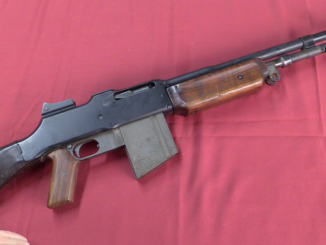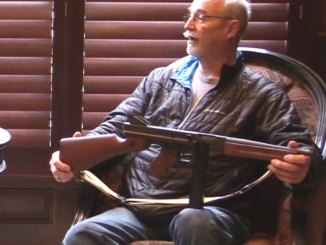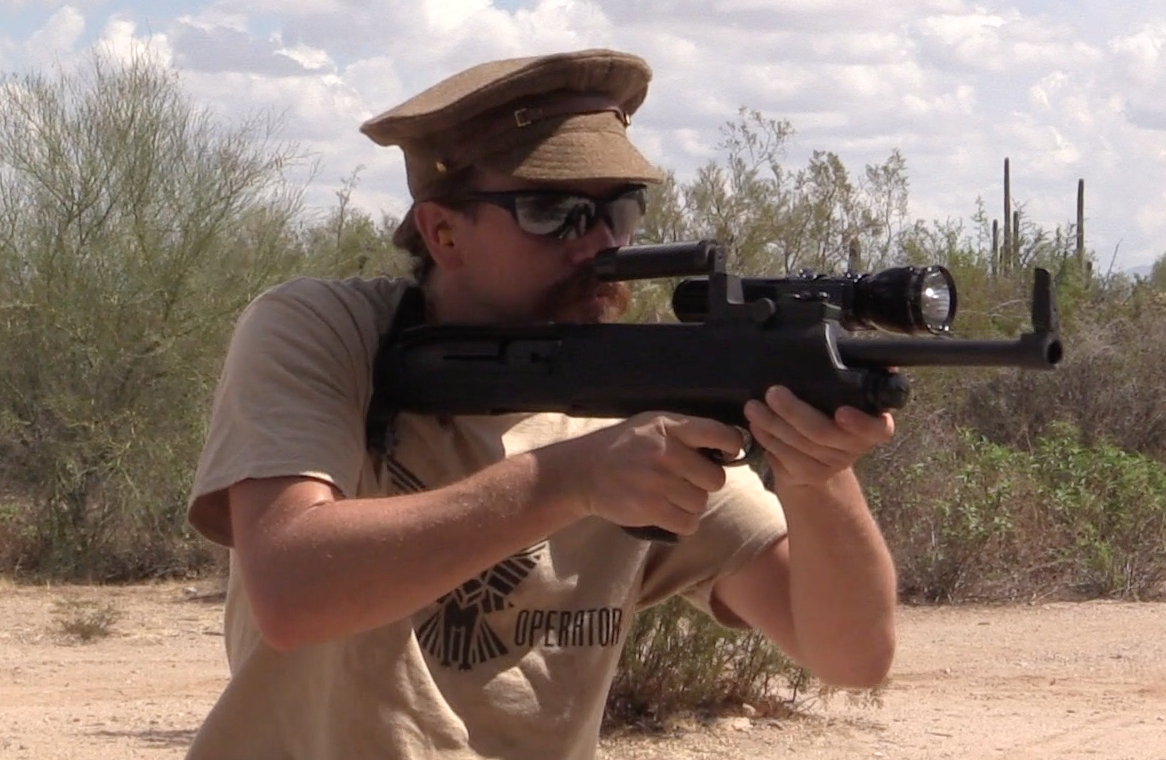Got a question from a friend, which is outside my area of knowledge. Does anyone know about the history of smoothbore, .45-caliber Trapdoor Springfield rifles? This fellow bought what was advertised as a forager conversion, but it clearly is not a forager. Aside form the caliber difference, it doesn’t match the date or serial number patterns for a forager.
This particular gun is dated 1873, and has a serial number in the 120,000 range. It appears to be all arsenal-modified, with proper markings and workmanship. The stock has a cleaning rod slot professionally filled, and it has a .45 caliber smoothbore barrel, with a .45-70 chamber. We know there were .45-70 shot cartridges produced during the 1880s (the owner of this rifle has one), but we aren’t able to find much (or any!) information about arsenal conversions of Trapdoors into this type of fowling setup. I don’t have photos, but may be able to get some. I understand that Bannerman built guns along these lines, but this one really doesn’t feel like a Bannerman conversion.
Does anyone know about possible provenance for these? My depth of knowledge on Trapdoors is pretty shallow, and this particular gun is over my head.




I think there may have been some that were modified for .410 shot shells
I got to thinking about studying old catalogs – especially turn-of-the-century Sears and Wards – and seemed to recall that the .410 didn’t appear until the smokeless era. According to Wikipedia (never a sure bet) it was introduced around 1900. More likely the .410 was developed from the .45-70 shotshell which had been around for 20 years. Don’t know anything about arsenal-made forager guns but it would make sense that there was such a thing… the troops on the Western frontier were often dependent on game for rations. Any idea if the .45-70 shotshells (all brass, I assume) have thick rifle-caliber walls or are drawn thin like the brass shotgun shells of the era? In other words, factory made as shotshells or reloaded from used rifle brass?
.410 case head is smaller than the .45-70, and approximately the dimensions of .303 British case head. unfortunately I don’t have exact drawings to hand to know whether it is closer to the .303 british or the very similar .30-40 Krag case head.
We also have some of the rimmed Mannlicher rounds with similar dimensioned heads to add to the confusion.
“I don’t have exact drawings”
Try http://www.municion.org/ – it is Spanish but it’s very clear dived into center-fire, rim-fire and pin-fire categories. But remember that all dimensions are in millimeters (mm).
http://gunlore.awardspace.info/shotgun/fourtenHistory.htm
States that “The origin of the .410 Gauge and it’s date of introduction are somewhat murky.” and that .410 can be derivation of .44-40 WCF. However municion states that .410 Bore = 36 gauge = 12mm, and listed pinfire 12mm shotshell in the .410 Bore site.
You can found additional about the very complicated 36 gauge history here:
http://www.fourten.org.uk/36gauge.html
Thanks! I had never heard the .410 referred to as a 36-gauge (12mm smoothbore rings a bell from somewhere.) I’ve seen articles about and photos of 32 and 24 gauges (mostly English or Italian custom doubles) but don’t think I’ve ever seen one. The 28 gauge seems to be making one of its periodic comebacks at the moment; I’ve noticed everything from custom-shop Ithaca bottom-shuck pumps – all new Ithacas are pretty much custom or at least limited-run, but the 28s are more so – to a New England Firearms breaktop single.
99.9% of them on the market are either fakes or civilian conversions, a la Bannerman. I would never buy one without serious proof it was real. If you don’t have it, Flaydermans Guide to Antique American Firearms is well worth the purchase, and these are covered a little in that book. If I remember correctly the few legitimate ones that were made fired a short 20 gauge shell.
We should know the actual bore diameter of this particular firearm. I suspect that this gun can be firearm with unfinished barrel – it can be true if the actual bore-diameter is equal to bore-diameter-(lands) for .45-70. But I don’t know what was made first – rifling or chamber?
This is a Trapdoor Springfield foraging gun;
http://www.rockislandauction.com/viewitem/aid/55/lid/1343
From all indications, they were 20 gauge shotguns, made as such; note the unusual contour of the breechblock compared to the standard breechblock. All found so far were dated 1881, which strongly indicates that they were made in a single production block at Springfield.
The .45-70 shot load would probably have been in inventory for units which did not have foraging guns, or just for issue to anyone who requested them.
Remember that officers were issued special “Officer’s Model” trapdoor carbines, with higher grades of finish, better sights, etc., and it’s entirely possible that officers with those (or privately-purchased rifles chambering the service round, like Custer’s famous Remington Black Hills rolling block), would have drawn such ammunition from store for foraging themselves.
I’m not aware of any “conversions” of .45-70 Springfields to smoothbore shot load use, as such. But D.C. Cole, in the article “Firearms in Apache Tribal Use” in the 1981 Gun Digest Annual states that .45-70 trapdoors were routinely used as shotguns by the tribe in his youth (1930s-40s), loaded with .410 shotgun shells.
Also, muzzleloading percussion plains rifles of .50 to .54 caliber were also used with ball or shot at that time; since their soft iron barrels had long ago had their rifling worn away by heavy use, they were essentially 28-gauge smoothbores at that point in their lives.
cheers
eon
I have a 1884 smooth bore carbine it’s barrel is abt 20 inches it has filled rod slot and a 46 projectal will slide thru a 50 gets stuck in chamber. I have a magazine I purchased in 1969 with a article about trap doors it has a chart of year by year info with mimbers of various types made for each year. It was provided complements of a gentleman from Dixie gun works. It stated that a footnote on some issues and the 1888 note stated that that year ” 100 1884 with positive cam and one rifle not rifled or chambered. My carbine appears to fit the description. I reload and have knowledge of possible cartridges and shot gun gauges 410 to small 28 and 32 appear to be to large. I have looked into my barrel and can see no definition of a chamber Could mine be that one I have no idea I’m not a professional but it’s hard to tell what the armory had in mind. The carbine has one band and only one sling loop on the back of the trigger guard and it’s 41 inches oal. It’s also in very good shape.
Some 1886 Winchesters were made in 45-70 smoothbore as line thrower guns.
Perhaps the same use ?
I wouldn’t use a 410 in a 45-70 chamber , it would bulge very badly and probably gas would escape backwards.
That was my thinking. Actually, I came to touch with naval line launcher but based on 10ga shotgun. I believe they used Springfield previously.
http://en.wikipedia.org/wiki/.45-70 states that:
“The .45-70 cartridge is still used by the U.S. military today, in the form of the CARTRIDGE, CALIBER .45, LINE THROWING, M32, a blank cartridge which is used in a number of models of line throwing guns used by the Navy and Coast Guard. Early models of these line throwing guns were made from modified Trapdoor and Sharps rifles, while later models are built on break-open single-shot rifle actions.”
But it particular firearm we discussed is in fact a line-thrower it should retain trails of means of mount for the box for line. Moreover, so far I know the Trapdoor line-thrower are shortened (sawn-off) firearms – any information about full-length line-thrower?
My suggestion would be to do a chamber casting and measure the result.
Eh, line-throwing guns for naval use aren’t always attached to “the box”: for some, you stand next to the line — which is either coiled on the deck or ground, or in a box — and fire the line-carrying rod. I’ve seen line guns (and very similar harpoon guns) made on just about any large-bore single-shot action.
The “line box”, if used, might not require any modification to the gun. Here’s a pic at guns america (not a Sprinfield, but it illustrates the point):
http://www.gunsamerica.com/UserImages/684/906905226/wm_1062178.jpg
The metal can is clamped on; it’s not clear if the gun itself had to be modified for that. If your friend’s gun has a couple of suspicious flats on the fore stock, or wear on the barrel from a couple of extra bands/clamps, those might be signs it was a line gun.
—
Michael B.
I have come across a story where someone had bought a shot out trapdoor and then overbored the barrel to take out the rifling and make a choke in the barrel. However I cannot remember the source, I want to say Hatcher’s notebook but I cannot find it.
I would suggest it was reamed out by a gun smith or black smith. many of those trap doors found their way into civilian hands especially as as newer models came out. As in after the Civil War, the first thing a civilian would do is find teh nearest gun smith or black smith to have the rifling reamed out. That way they could forage with it and shot was a lot cheaper than slugs. I have one 1873 and a 1884 trap doors with both very original. I have seen many that were reamed out to smooth bore that were sold off as “surplus” and reamed out. Also the rifling in the trap doors is not that deep so I have seen some that basically were shot out.
IMHO if it is a smooth bore that has not een shot out and has NO hint of rifling, I would venture to say it is one that some farmer got a hold of, had it reamed out, and used it to feed his family small game.
Then again all is pure speculation without pictures.
I remember reading an article in “backwoodsman” magazine about Bannerman’s surplus (I’m sure you know who they were) doing this to a large quantity of trapdoors, but I can’t for the life of me find the article.
For reference, the base diameter of factory .410’s is 0.469″, and the rim diameter is 0.524″. .444 Marlin cases are straight walled and can be used as .410 brass without the need for fireforming, but have the penalty of a 2.162″ case length. The base diameter of the .444 Marlin is 0.469″, whereas the .303 British has a base diameter of 0.458″. The rim diameter is smaller with the .444 Marlin – 0.514″ instead of the 0530″ rim diameter of the .303 British – so it is theoretically possible that a really loose extractor might not catch the rim. The 9.3 x 74R European brass has a base diameter of 0.465″, a rim diameter of 0.524, and an overall length of 3.47″. The rim thickness (headspace) of the 9.3 x 74R, however, can be a tight fit in minimum .410 bore shotgun chambers, and may need to be thinned before use. Obviously we’re only talking a few hundreds or thousands of an inch differences here, but it is a complication not taken with abandon.
45-70 is:
Neck diameter
.480 in (12.2 mm)
Base diameter
.505 in (12.8 mm)
Rim diameter
.608 in (15.4 mm)
Rim thickness
.070 in (1.8 mm)
Id say its after market. Like mentioned above, a farm shotgun, Ive seen these .410’s before.
Trapdoor Foragers (20 gauge) were issued 2 per company for hunters & scouts of western outposts. Many of those “Zulu” shotguns were also issued out to Western Units for hunting.
Last known offical issue of one was in 1906 in Alaska.
Got this info from: “Flandermans Guide to Antique American firearms” 9th edition.
Could it be a harpon gun, as used on a whaling ship?
Perhaps the simplest explanation is a well done gunsmith conversion for .45-70 shot loads. In the old days it was common for gun owners to load their own shotshells, and if you do that they can be in whatever size you like.
As above, the .410 shell is not a very close match to the .45-70 chamber in the gun. But it is not necessary to try to explain the gun in question in light of the .410 since there is a good chance it was used with roll-your-own small game shells in ‘gummint’ casings.
The only armory-built foraging shotgun Trapdoors I’m aware of were 20 gauge. However, I am not aware of everything, which is a useful philosophical reflection in general and particularly good to remember when looking at old guns. 🙂
I hawe seen Lee Enfields and Ross rifles modified to the 410 round, so wy mot a trapdor.
It was told that certen contryes, had restrictions on rifles, but not on smooth bores and that they were modyfied in England, for the bennefit of collectors
It’s probably a Model 1881 Forager made up of parts at Springfield with a reamed out barrel. Was an article in one of the gun mags I get (G&A??) a month or so ago that really gave a good description. They were chambered for 20 gauge shotshells.
First thing to ask, what’s the bore diameter? If it’s less then the .458 of standard 45-70 grooves you know it left the arsenal that way. If it’s much larger it’s most likely a reamed rifle.
Here I was going to suggest Robert Frasca’s “The .45-70 Springfield” but it looks like you guys have everything well in hand.
Well,for what it’s worth, I’ve got a smoothbore 1873 put up by Abercrombie & Fitch as a harpoon gun. 116,000 serial range. The barrel has been shortened, & as per the parts list in the cased set, there was no attached line holder. The line is to be coiled in a keg at the shooters’ feet, as per the instructions. As far as any information out there on these, good luck. I’ve researched till I’m blue in the face. Was still looking when I ran across your thread.
Sorry, serial range 116xx
I have a 1873 springfield. The bore which came extreemly filthy , after scrubbing seems to be smooth but I can detect a slight swirl. Could this be the swirl of a damaskis barrel.? or is my barrel shot out ? Carbine stock with a longer barrel
i have a cased a.and f.harpoon gun a trapdoor carbine mod.1873 #28,xxx with original instructions and contents list on a.and f.paper.missing oil and grease cans and one brass dart came with 3 barrel is shortened and bored out.the brass dart with line tied to it fits on a leather tipped wood dowel rests against the blank cartridge the dart is split so it slides into the sight.the a. and f. sporting goods store was located on Madison Ave at 45th.Street,New York.Photos on request
Bob- I would be interested in pics. I collect old line guns and would like to see what you have available.
If interested please contact me through gmail using swamp2120 for pics.
I just purchased a genuine Forager from Leroy Merz. While most of the parts used in producing the guns were surplus, two critical parts, the breechblock and receiver, had to be purpose made due to the difference in size between the 20 gauge case and the 45-70 case. Since the receivers had to be purpose made Springfield assigned them their own serial number range starting with 1. A total of 1,367 were made between 1881 and 1885. All breechblocks are dated 1881 in Italics, and there are no other marks on the breechblocks. Other changes were required. A genuine Forager will not have the standard 45-70 extractor, but instead has a wide extractor that hinges from the top of the chamber. There is also no ejector stud in a Forager, nor even a hole for one to be mounted. Due to the larger case size the stud interfered with the extraction process. There are other little tell-tales involved with the Forager, but these are the biggies. The first thing is to check the serial number. If its higher than 1,367 you have some sort of after market product a’ la Francis Bannerman or Hartley & Graham, et al, or possibly a more modern fake.
My bad. I’m getting dyslexic in my old age. The serial range is 1 to 1376, not 1367, so a serial number higher than 1376 indicates a weapon of non-Springfield origin.
I have an 1873 Springfield Trapdoor smooth bore with 30″ barrel. Appears to be a 20 gauge. Inside Muzzle diameter is .622. Stock has wooden filler plugs around the two receiver screws. Serial is 24xxx. No barrel band, appears to be shorter stock. Any ideas what I have? Thanks for any information.